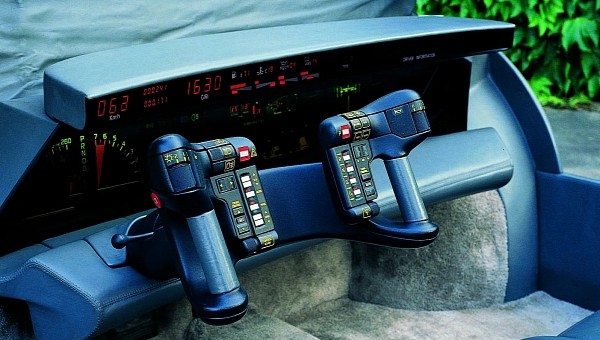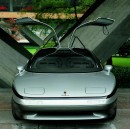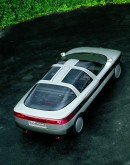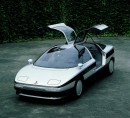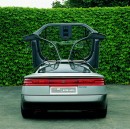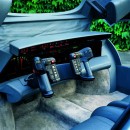“You can’t reinvent the wheel.” This phrase very vividly and visually describes a simple yet powerful philosophy: if it works, don’t change it. And when it comes to the automobile industry, the concept is rock-solid and grounded in the core beliefs of carmakers. But is it really that unmovable?
Sometimes manufacturers dream of revolutionizing the industry with a new, bold, and innovative approach to the personal transportation matter. Take the hero of this article, for example - a sleek, futuristic, clean-looking automobile that features some paradigm-shifting design ideas. Say Hi to the Oldsmobile Incas concept of 1986, the brainchild of Giorgio Giugiaro’s Italdesign company.
The four “doors,” for instance. Well, mathematically speaking, there aren’t four of them. And from an engineering point of view, they aren’t all doors. Let’s break it down: rear access is granted via the gullwing doors – two of them (inspired by the Porsche Tapiro from 1970 and the Italian styling office).
At the front, the driver and passenger are met with a non-traditional entry and exit facilitator: the doors are gone, and a bulbous half-canopy (covering the whole front section) tilts forward to allow passengers into the first row of seats. These, by the way, are not what we’d call regular car seats but have a strong resemblance to armchairs. The same solution is offered at the back for maximum comfort.
Furthermore, the exterior is a distant reminder of the DeLorean DMC-12, thanks to the paintless color scheme. Just like the time-warping automobile of Doc Emmet Brown, the Oldsmobile Incas features a brushed metallic shell. The pop-up headlights were not a never-before-seen car design idea, but it was a trendy choice in the mid-80s.
The profile of the Olds concept – look at it in the gallery – bears a slight reminiscence of a fighter jet cockpit, with the predominantly glass bubble across the occupants and the mid-rear engine. A non-mainstream powerplant, just like the whole car, despite the discrete deviations from the industry standards of the era.
The inline-four plant was a little – by American standards – 138 CID (2.26-liter) engine that outperformed its small displacement with a respectable 230 bhp (233 PS) score. How could it squeeze that big of a stud from that disappointingly small engine? With the magic of the turbo. Or turbos, to be precise, because the Incas concept featured a piston-to-turbo ratio of 1:1. A quad-turbo answer to the “lots of power from a little engine” problem.
To further separate itself from the rest of the automobile world, the Oldsmobile concept had its rear engine mounted transversally. And all four wheels would pull the car on its way, thanks to a permanent four-wheel-drive system.
All nice and good so far, but the absolute striking feature of the Olds concept was lurking inside, waiting for the driver. The steering… errrr? Device? Yoke? Joystick? Cloche? Command bar? Thingy? We could call it lots of names, but not a wheel. Oldsmobile and the Italians of Italdesign did reinvent the (steering) wheel, after all.
Whatever name the driver gave it, the surprise was total. First of all, its shape: two vertical handles united in purpose by a half-circle connecting arch going behind them, rather than below, above, or between. And then, there were the buttons: everything was controlled from the steering unit, apart from the brakes and acceleration. And we mean everything. There aren’t any other buttons, levers, knobs, or sliders in the car. Please take a good long look at it in the gallery: the dashboard is as deserted as Death Valley.
The Italians that came up with the idea called it “joysticks” – the Latin exuberance in their four-seats coupe is omnipresent. Inspired by a 1985 Mazda market research - and a design that ensued from that large-scale study – the Oldsmobile Incas joystick based its philosophy on the trending tendencies of new generations of drivers. In brief, that Japanese study said that new generations of car buyers, growing up with videogames, prefer the cloche instead of the traditional steering wheel. (A wild prophecy, or did Mazda invent the time machine and pay a short visit to 2022?)
With a very narrow lock-to-lock angle of just 90 degrees, the joystick was clad with buttons: gearbox commands, air-conditioning, and windshield wipers on the right-hand side. Lights, turn indicators, stereo, and cruise control were on the opposite half. As for the horn, the designers probably anticipated the driver to be busy enough as it was with the unusual steering unit, and they placed horn buttons on both sides.
The digital age forerunner also sported a video game-inspired dash: all instruments were LCD (think first-generation alarm clocks). The dash provided casual information (basic engine stats, like oil pressure, water temperature, fuel level, gear, speed, or RPM) despite its high-tech look. The design was way ahead of available car technology at the time.
The sporty coupe was a compact car, just 175 inches long (4.4 meters), almost 73 inches wide (1.85 meters), and 49 inches tall (1.25 meters). However, thanks to its wheelbase of 113.2 inches (2,875 mm), the Incas was just as spacious as a full-size sedan. Far ahead of its time, the car never made it past the concept stage, but its vision of the car's future turned out to be very accurate.
The four “doors,” for instance. Well, mathematically speaking, there aren’t four of them. And from an engineering point of view, they aren’t all doors. Let’s break it down: rear access is granted via the gullwing doors – two of them (inspired by the Porsche Tapiro from 1970 and the Italian styling office).
At the front, the driver and passenger are met with a non-traditional entry and exit facilitator: the doors are gone, and a bulbous half-canopy (covering the whole front section) tilts forward to allow passengers into the first row of seats. These, by the way, are not what we’d call regular car seats but have a strong resemblance to armchairs. The same solution is offered at the back for maximum comfort.
Furthermore, the exterior is a distant reminder of the DeLorean DMC-12, thanks to the paintless color scheme. Just like the time-warping automobile of Doc Emmet Brown, the Oldsmobile Incas features a brushed metallic shell. The pop-up headlights were not a never-before-seen car design idea, but it was a trendy choice in the mid-80s.
The inline-four plant was a little – by American standards – 138 CID (2.26-liter) engine that outperformed its small displacement with a respectable 230 bhp (233 PS) score. How could it squeeze that big of a stud from that disappointingly small engine? With the magic of the turbo. Or turbos, to be precise, because the Incas concept featured a piston-to-turbo ratio of 1:1. A quad-turbo answer to the “lots of power from a little engine” problem.
To further separate itself from the rest of the automobile world, the Oldsmobile concept had its rear engine mounted transversally. And all four wheels would pull the car on its way, thanks to a permanent four-wheel-drive system.
All nice and good so far, but the absolute striking feature of the Olds concept was lurking inside, waiting for the driver. The steering… errrr? Device? Yoke? Joystick? Cloche? Command bar? Thingy? We could call it lots of names, but not a wheel. Oldsmobile and the Italians of Italdesign did reinvent the (steering) wheel, after all.
The Italians that came up with the idea called it “joysticks” – the Latin exuberance in their four-seats coupe is omnipresent. Inspired by a 1985 Mazda market research - and a design that ensued from that large-scale study – the Oldsmobile Incas joystick based its philosophy on the trending tendencies of new generations of drivers. In brief, that Japanese study said that new generations of car buyers, growing up with videogames, prefer the cloche instead of the traditional steering wheel. (A wild prophecy, or did Mazda invent the time machine and pay a short visit to 2022?)
With a very narrow lock-to-lock angle of just 90 degrees, the joystick was clad with buttons: gearbox commands, air-conditioning, and windshield wipers on the right-hand side. Lights, turn indicators, stereo, and cruise control were on the opposite half. As for the horn, the designers probably anticipated the driver to be busy enough as it was with the unusual steering unit, and they placed horn buttons on both sides.
The digital age forerunner also sported a video game-inspired dash: all instruments were LCD (think first-generation alarm clocks). The dash provided casual information (basic engine stats, like oil pressure, water temperature, fuel level, gear, speed, or RPM) despite its high-tech look. The design was way ahead of available car technology at the time.
